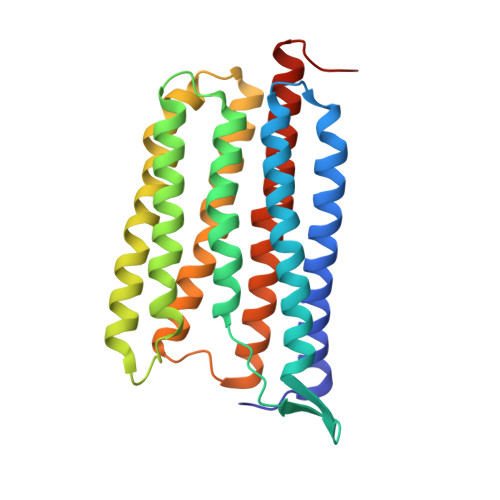Phototrophy by antenna-containing rhodopsin pumps in aquatic environments.
Chazan, A., Das, I., Fujiwara, T., Murakoshi, S., Rozenberg, A., Molina-Marquez, A., Sano, F.K., Tanaka, T., Gomez-Villegas, P., Larom, S., Pushkarev, A., Malakar, P., Hasegawa, M., Tsukamoto, Y., Ishizuka, T., Konno, M., Nagata, T., Mizuno, Y., Katayama, K., Abe-Yoshizumi, R., Ruhman, S., Inoue, K., Kandori, H., Leon, R., Shihoya, W., Yoshizawa, S., Sheves, M., Nureki, O., Beja, O.(2023) Nature 615: 535-540
- PubMed: 36859551
- DOI: https://doi.org/10.1038/s41586-023-05774-6
- Primary Citation of Related Structures:
7YTB, 8I2Z - PubMed Abstract:
Energy transfer from light-harvesting ketocarotenoids to the light-driven proton pump xanthorhodopsins has been previously demonstrated in two unique cases: an extreme halophilic bacterium 1 and a terrestrial cyanobacterium 2 . Attempts to find carotenoids that bind and transfer energy to abundant rhodopsin proton pumps 3 from marine photoheterotrophs have thus far failed 4-6 . Here we detected light energy transfer from the widespread hydroxylated carotenoids zeaxanthin and lutein to the retinal moiety of xanthorhodopsins and proteorhodopsins using functional metagenomics combined with chromophore extraction from the environment. The light-harvesting carotenoids transfer up to 42% of the harvested energy in the violet- or blue-light range to the green-light absorbing retinal chromophore. Our data suggest that these antennas may have a substantial effect on rhodopsin phototrophy in the world's lakes, seas and oceans. However, the functional implications of our findings are yet to be discovered.
Organizational Affiliation:
Faculty of Biology, Technion-Israel Institute of Technology, Haifa, Israel.
















